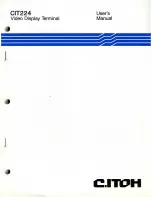
12
The LSB is extracted and examined. If the LSB was a 1, the register is then exclusive ORed with a preset, fixed value
(A001 hex). If the LSB was a 0, no exclusive OR takes place.
This process is repeated until eight shifts have been performed. After the last (eighth) shift, the next eight-bit character
is exclusive ORed with the register's current value, and the process repeats for eight more shifts as described above. The
final contents of the register, after all the characters of the message have been applied, is the CRC value.
Generating a CRC
Step 1
Load a 16-bit register with FFFF hex (all 1's). Call this the CRC register.
Step 2
Exclusive OR the first eight-bit byte of the message with the low order byte of the 16-bit CRC
register, putting the result in the CRC register.
Step 3
Shift the CRC register one bit to the right (toward the LSB), zero filling the MSB. Extract and
examine the LSB.
Step 4
If the LSB is 0, repeat Step 3 (another shift). If the LSB is 1, Exclusive OR the CRC register with the
polynomial value A001 hex (1010 0000 0000 0001).
Step 5
Repeat Steps 3 and 4 until eight shifts have been performed. When this is done, a complete eight-bit
byte will have been processed.
Step 6
Repeat Steps 2 ... 5 for the next eight-bit byte of the message. Continue doing this until all bytes have
been processed.
Result
The final contents of the CRC register is the CRC value.
This CRC value is then appended to the message. The LSB of the CRC is sent first followed by the MSB.
Multidrop Operation:
Multidrop operation is possible. A unique unit address between 1 and 247 has to be given to each instrument by using
the display keypad and in-built menus. Refer to the instruction manual for more information.
Command <MC
n
> Make Connection is used to define the instrument address (
n
) to which subsequent commands are
directed. This “virtual connection” remains in force until it is explicitly released by issuing the <RC> release
Connection command. These two commands are necessary in order to confirm that all instruments receive and react to
the commands successfully. Once connected, the units respond in exactly the same way as a single units would, with
error responses being issued if a problem occurs.
If a unit has a non-zero address, then on power-up, a <MCn> command must be sent prior to any other command, even
if it is the only unit on the line.
















































